- Quick Read
- Deep Read ( 6 Min. )
Monitor Daily Podcast
- Follow us:
- Apple Podcasts
- Spotify
- RSS Feed
- Download
TODAY’S INTRO
Goodbye, conventions. Long live the conventions!
I will never forget my first political convention: the Republican confab in sunny San Diego, August 1996. Hopes were high for GOP nominee Bob Dole, though everyone knew unseating President Bill Clinton would be tough. Senator Dole famously didn’t read the party platform, but at least folks had fun – especially those decked out in red, white, and blue, as I wrote.
This year the conventions are effectively canceled. The Democrats (Aug. 17-20) are going all-virtual, and the Republicans (Aug. 24-27), for now, will be mostly virtual. President Donald Trump says he may accept the GOP nomination from the White House.
For years, it has been fashionable to dismiss the conventions as “infomercials,” all packaging and glitz, with nothing left to chance. Reporters’ quadrennial hopes for a brokered convention are predictably dashed. This year, some are even celebrating the gatherings’ demise. “Covid killed the conventions. Maybe that’s a good thing,” wrote Politico.
Indeed, this year’s busted play is an opportunity to rethink, well, the convention of conventions. As with many aspects of life, the pandemic has forced us to consider new ways of doing things – sometimes for the better. Maybe hybrid conventions, a combination of virtual and in-person events, are the future.
But for people who love politics, nothing beats a real, live gathering. Connections are made, wisdom passes from old to young, political stars are born. The expressions of free speech – including protesters, as long as they’re peaceful – are an important part of the tradition. And who can argue with all the fabulous red-white-and-blue outfits?
Share this article
Link copied.

Help fund Monitor journalism for $11/ month
Already a subscriber? Login

Monitor journalism changes lives because we open that too-small box that most people think they live in. We believe news can and should expand a sense of identity and possibility beyond narrow conventional expectations.
Our work isn't possible without your support.
How ‘success’ of US Iran policy has benefited China
The history of national security policy is famous for unintended consequences (e.g., the Iraq War and ISIS). Now add to the list the heavy U.S. pressure on Iran and a Chinese foothold in the Middle East.

Certainly the Trump administration did not set out to drive Iran into China’s arms when it developed its “maximum pressure” strategy against Tehran. Its stated purpose was to punish Iran economically until Tehran came back to the negotiating table to hammer out, in the U.S. administration’s view, a better deal on Iran’s nuclear program.
The Trump policy succeeded in the first part, but not in the second. And now a rising China, America’s top adversary, is swooping in to rescue Iran’s economy, and thwart U.S. diplomacy at the same time. After recent talks, Beijing and Tehran declared that negotiations on a 25-year strategic partnership would continue, with a goal of finalizing a deal within a few weeks.
It’s not that the Iranians have eagerly embraced Beijing’s economic rescue, regional experts say.
“If this strategic partnership ends up baked the way we’re hearing it described, it’s a huge erosion of Iranian sovereignty and acknowledgment by the Iranians that the current [economic] situation has them in truly dire straits,” says security expert Ilan Berman. It “basically says the regime has decided, ‘We’re better off in charge of half the country than losing the whole thing.’”
How ‘success’ of US Iran policy has benefited China

With relatively little effort, the Trump administration’s “maximum pressure” campaign on Iran can be seen as both a resounding success and as an abject failure underscoring the United States’ receding influence in global affairs.
Now add to the negative side of the U.S. balance sheet a potentially substantial and long-term foothold being provided to a rising China in the Middle East.
No one questions that the two-year-old policy of harsh sanctions targeting both Iran and other countries willing to cross the U.S. and do business with Tehran has brought the Iranian economy to the brink of collapse. That’s the policy’s “success.”
But if the administration’s goal in imposing that economic misery was to bring Iran back to the negotiating table to reach a “better” nuclear deal, as well as to alter Iran’s “malign behavior” in its neighborhood, the pressure has largely failed.
In announcing the policy in May 2018, Secretary of State Mike Pompeo listed 12 “very basic requirements” Iran would have to meet to win relief from crushing sanctions and get on a path to a new nuclear deal. None of the requirements – ranging from no uranium enrichment and no ballistic missile development to curtailing the undermining of Iran’s neighbors and an end to threats against Israel – has been met, most experts agree.
Perhaps more important, the U.S. has failed to bring many countries along on its approach toward Iran, revealing its waning influence since it left the multinational 2015 Iran nuclear deal in 2018.
On Thursday Secretary Pompeo announced the departure of his special envoy on Iran, Brian Hook. Over his more than two years in the envoy role, Mr. Hook tenaciously pursued the strangulating sanctions that formed the backbone of the maximum pressure policy, and had some success in rallying Arab partners to the U.S. cause. But overall, his departure struck many foreign policy observers as further evidence of the dead end that Iran policy has reached.
Space “filled by China”
Moreover, that waning U.S. influence and ensuing American isolation have opened the door to China to swoop in and rescue an Iranian economy on the brink with a blockbuster strategic partnership deal that many experts say will provide Beijing with a powerful foothold in the region.
“Clearly the U.S. maximum pressure strategy has profoundly surprised the Iranians in how successful it has been at choking the Iranian economy – that part of it has worked,” says Alex Vatanka, director of the Iran program at the Middle East Institute (MEI) in Washington.
“But what it didn’t accomplish was bringing the Iranians back to the table to negotiate a new nuclear deal, as the U.S. failed to articulate exactly what it wanted,” he says. “That has alienated everyone, including the friends and allies the U.S. might have brought along, and that has created a widening space between the two sides – and that space has been filled by China.”

China has decided it wants to be more than “just” an economic power and seeks to play a larger role in key regions like the Middle East, Mr. Vatanka says. “They are looking for vacuums where they can exert their power,” he adds, “and they have found a major one in Iran.”
Certainly the Trump administration did not set out to drive Iran into China’s arms when it developed the maximum pressure strategy. Nor have the Iranians eagerly embraced Beijing’s economic rescue, regional experts say – it’s just that the country’s leaders, and in particular the supreme leader, Ayatollah Ali Khamenei, have concluded it’s either that or risk collapse.
“If this strategic partnership ends up baked the way we’re hearing it described, it’s a huge erosion of Iranian sovereignty and acknowledgment by the Iranians that the current [economic] situation has them in truly dire straits that can’t keep going much longer,” says Ilan Berman, senior vice president of the American Foreign Policy Council in Washington and an expert in Middle East security.
“It has them hitching their wagon to [China’s] Belt and Road initiative in a significant way,” he adds, “and basically says the regime has decided, ‘We’re better off in charge of half the country than losing the whole thing.’”
Beijing and Tehran declared after recent talks that negotiations on a 25-year strategic partnership would continue, with a goal of finalizing a deal within a few weeks.
Countering U.S. pressure
Even as China has been negotiating the new partnership, it has been working to thwart U.S. pressure on the Iranian regime – and to highlight America’s deepening isolation from the rest of the world on a number of key international diplomatic matters, including Iran’s nuclear program.
At a recent United Nations Security Council session at which the U.S. pressed to extend an Iran arms embargo set to expire in October, China dismissed the American initiative as baseless because the U.S. is no longer a party to the Iran nuclear deal, also known by the acronym JCPOA, which includes the embargo.
“China opposes the U.S. push for extending the arms embargo in Iran,” said China’s U.N. ambassador, Zhang Jun, at the June 30 Security Council meeting. “Having quit the JCPOA, the U.S. is no longer a participant and has no right to trigger a snapback” to reimpose U.N. sanctions on Iran.
Mr. Pompeo also failed to muster support from European allies on the council, underscoring the lonely American stance on Iran.
Germany, France, and even Britain had hoped to use the JCPOA to rebuild economic ties to Iran and develop Iran’s “historic pivot to Europe,” Mr. Berman says. But he says U.S. policy – in particular the secondary sanctions targeting foreign companies doing business with Tehran – thwarted European aims and “forced the Iranians to turn elsewhere.” That “elsewhere” is to some degree Russia, he says, but primarily China.
Indeed Mr. Vatanka of MEI says the China partnership could signal the finalization of Iran’s “protracted divorce process” from the U.S. and the West more broadly that started with the 1979 Iranian revolution.
After failing on his first go at extending the Iran arms embargo, Secretary Pompeo now says he will try again – and that the U.S. will proceed to take “necessary action” to ensure that Iran does not import proscribed arms if the embargo expires.
But in light of the dearth of support for the U.S. position, the likelihood of Mr. Pompeo winning an extension before the October expiration seems virtually nonexistent, most experts say.
As Mr. Berman notes, all the parties involved are “hedging their bets” given the proximity of the U.S. presidential election and the possibility that U.S. policy on Iran could shift back to a more traditional diplomatic approach should President Donald Trump lose his reelection bid.
Moving on from Iran
In any case, the Iranian issue has lost much of the “salience” it had in Washington just a couple of years ago, says Mr. Vatanka.
It is true that a group of congressional Republican hawks called the Republican Study Committee recently issued a report on the Middle East, with particular attention to Iran’s “rogue activities” in the region and steps the U.S. should take to counter them. Those should include even tougher sanctions on Iran’s “vital sectors” and the designation of Iranian-backed “proxy militias” as terrorist groups, the group said.
And at a recent appearance by Secretary Pompeo before the Senate Foreign Relations Committee, Democratic Sen. Robert Menendez of New Jersey blasted the Trump administration’s Iran policy for leaving Iran closer to acquiring a nuclear weapon than it was when the administration withdrew from the JCPOA.
But for the most part, Washington has redirected its sights to China as its No. 1 adversary, Mr. Vatanka says. As an example, he points to how “the China challenge” ended up dominating Mr. Pompeo’s Senate appearance, which was supposed to focus on Iran.
When it comes to America’s biggest threat, Mr. Vatanka says, “This town has moved on.”

The other people facing housing woes: Mom and pop landlords
Many landlords understand tenants’ needs during this time. But if they can’t meet their own financial obligations, it could have “a cascading effect ... the likes of which this country has never seen,” says one landlord advocate.
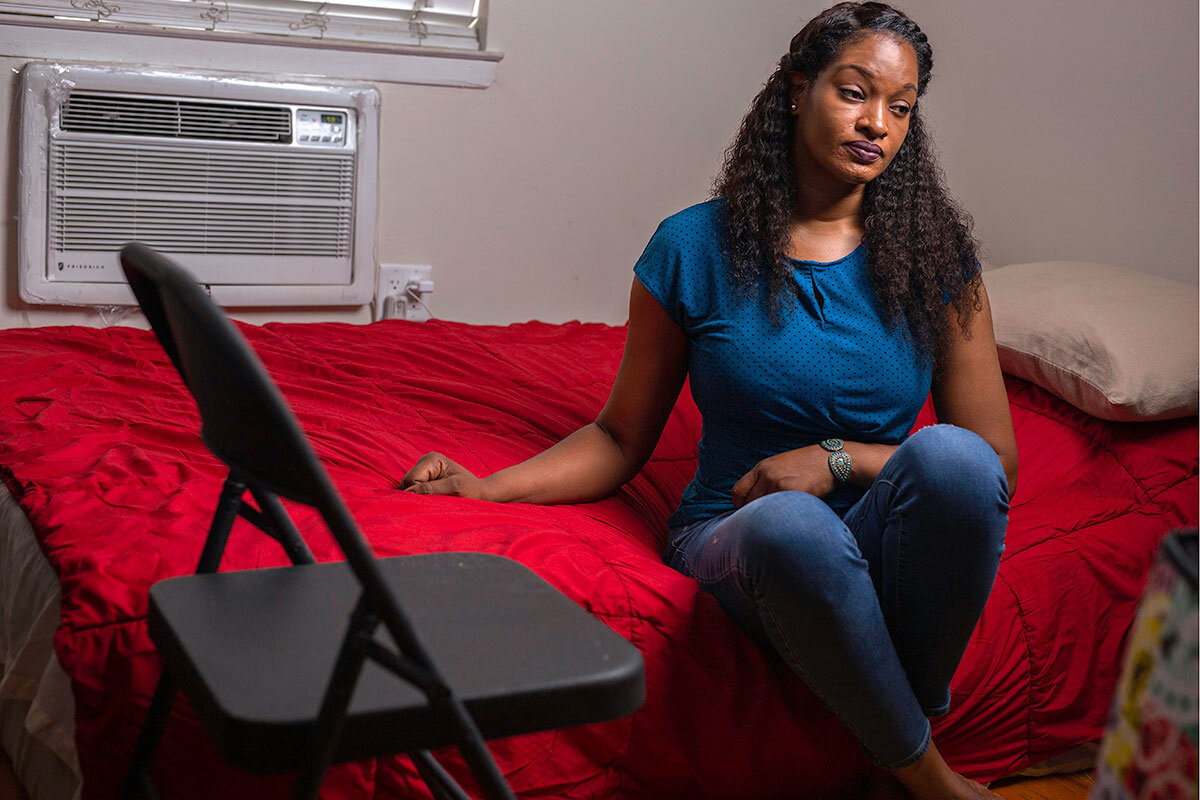
- Quick Read
- Deep Read ( 6 Min. )
-
By Hillary Chura Correspondent
Diamantis Kyriakakis’ family has owned a handful of walk-ups in Manhattan, Queens, and New Jersey since the 1990s. They do a lot of the work involved themselves, and they use the rental money to pay bills. COVID-19 hit them hard. Of all their tenants, only one retired man has kept current since March, Mr. Kyriakakis says. Everyone else is at least a month late.
“We still need the rent, but we’re also human. We understand people need to feed their families, and we have to support them in that,” Mr. Kyriakakis says.
For the past five months, America’s private landlords – numbering 10 million to 11 million, and owning 48% of U.S. rental units – have been struggling along with their tenants. When renters can’t make their payments, it has ripple effects on landlords who have to pay mortgages, property taxes, and other bills – and rarely have credit or cash to carry them through emergencies.
“The problem is that landlords are vulnerable, too. The assumption is that they’ve got deep pockets,” says Jonathan Miller of Miller Samuel, a real estate appraisal firm. “Oftentimes, the landlord is the same income status as the tenant.”
The other people facing housing woes: Mom and pop landlords
The peril for Americans who cannot pay rent because of COVID-19 is well established. Less apparent is the financial ruin that faces millions of mom and pop landlords who live rent check to rent check and need the income to pay bills.
Take Tina Brown. She’s a landlord in the Bronx, one of the five New York boroughs, and just as the lockdown set in, she lost the two-family house where she’d been living because her tenants had stopped paying rent years earlier. She’d like to move into her family’s other building. But she can’t because that tenant likewise stopped paying rent last year and cannot be put out because of the state’s eviction moratorium. Until things change, Ms. Brown is sleeping on her sister’s floor.
According to an analysis of government figures, the country has 10 million to 11 million private landlords, and they own 48% of all U.S. rental units. For the past five months, they have been struggling along with their tenants. Unlike millions of Americans and small businesses that received federal pandemic aid, small landlords have largely fallen through the cracks.
About 18% of American tenants couldn’t pay June rent, and 33% doubted they could do so this month, according to the Census Bureau. Unpaid rent has ripple effects on landlords who have to pay mortgages, property taxes, insurance, upkeep, and other bills – and rarely have credit or cash to carry them through emergencies.
“The problem is that landlords are vulnerable, too. The assumption is that they’ve got deep pockets and are all over the country or world. Oftentimes, the landlord is the same income status as the tenant, and they’ve got mortgages and obligations as well,” says Jonathan Miller, CEO of Miller Samuel, a New York-based real estate appraisal and consulting firm.
Editor’s note: As a public service, all our coronavirus coverage is free. No paywall.
A city of renters
Observers say the situation could be even worse in New York, one of the first cities to shutter. This is a city of renters – two-thirds of the population, which is over twice the national average, according to the Department of City Planning.
While some temporary eviction bans are expiring elsewhere in America, they’ve been extended in New York. As of July, landlords in this state must wait until coronavirus-related restrictions are lifted before they can evict anyone who lost income due to the pandemic.
Landlords say they’d rather work with renters than evict them, especially in a recession. Janice Hamilton, a Brooklyn landlord since 2003, has a longtime tenant who lost her job and is paying what she can.
“We’ll do whatever we need to do to work it out. She’s a good person, and she’s trying to pay,” Ms. Hamilton says. “You can either get a little money or zero dollars.”
Even in usual times, many private landlords are vulnerable because their tenants are. Low-wage workers – those particularly at risk for coronavirus-related layoffs – tend to rent from smaller landlords; better-paid workers have the ability to drift toward bigger buildings with more amenities that are run by large management companies. Such conglomerates can absorb lost rent from a few tenants, but landlords with a single unit don’t have that luxury.
Early in the pandemic, many banks allowed troubled landlords to defer their mortgages for three months and tack outstanding charges resulting from unpaid rent onto the end of their payment plan. Five months into the crisis, many financial institutions still say they will work with clients experiencing trouble because of COVID-19. But landlords know that will end one day.
Stopgap measures
In response to COVID-19, states, counties, and cities have set up or expanded almost 300 temporary rental assistance programs, many of which will pay landlords directly, according to the National Low Income Housing Coalition. But they are woefully underfunded – with some funds depleted in as few as 90 minutes, says Emily Benfer, co-creator of the COVID-19 housing policy scorecard at Princeton University’s Eviction Lab.
In Manhattan, the median market-rate rent for an 895-square-foot apartment in June was $3,378, according to Mr. Miller of Miller Samuel. That dollar figure may make it tough to believe that landlords are hurting. But many city apartments are in rent-controlled or rent-stabilized buildings where the rent runs a fraction of the market rate and may not cover costs. And a large portion of the buildings are a century old, requiring significant maintenance. Regardless of where one operates, high expenses can leave little for profit – or even maintenance.
With such razor-thin margins, landlords like Diamantis Kyriakakis’ extended family do a lot of work themselves. The family has owned a handful of walk-ups in Manhattan, Queens, and New Jersey since the 1990s. Mr. Kyriakakis, a chiropractor, still cuts lawns he’s been mowing since he was 10. When New York City was under stay-at-home orders this spring, his 60-year-old father kept going out to fix tenants’ leaky sinks, pipes, and toilets.
The Kyriakakis family uses the rental money to pay bills. COVID-19 hit them hard. Of all their tenants, only one retired man has kept current since March, Mr. Kyriakakis says. Everyone else is at least a month late.
“We still need the rent, but we’re also human. We understand people need to feed their families, and we have to support them in that,” Mr. Kyriakakis says. “There are some slumlords out there. They give a bad reputation to the rest of us.”
With New York state’s high property taxes, tenant-friendly laws, the city’s rent-regulated apartments, and provisions that mean evictions can take six months (pre-pandemic), longtime local landlords say owning a building now is harder than in the blighted 1970s and ’80s, when thousands of storefronts were boarded up and landlords abandoned their buildings.
“Being a good landlord is hard,” says Tracey Benson, president of the National Association of Independent Landlords. “You want to take care of your people, and your home. Tenants generally play by the rules. But there are others – tenants who tear doors off the cabinets and do other things most people wouldn’t even imagine.”
Rogue tenants
Some tenants have used COVID-19 to game the system. Lynne Haney, a sociology professor at New York University, has been renting her Brooklyn home to seven tenants since 2016. Two people were responsible for collecting the rent and sending it to her.
Late on March 31, she says, one of them emailed that they were all on rent strike and would be withholding the $6,500 monthly rent, starting the next day in April. Professor Haney replied that she understood times were hard, saying she’d work with tenants if they would pay what they could. The two organizers refused, said everyone was striking in solidarity with people who couldn’t pay, and cut communications. Two months later, Professor Haney says, she connected with the remaining five renters and found out they had been paying their rent all along – and that the organizers had kept the money while they relocated to Wisconsin. Professor Haney ultimately got the back rent but was especially galled because she, like many small landlords, keeps the rent low to help her tenants.

Ms. Brown, who’s unemployed, has been a landlord for 10 years. She figures it realistically could be March 2021 before she could remove her nonpaying tenant, assuming there is no second COVID-19 wave. Meanwhile, Ms. Brown says, the tenant has moved three more people into the two-bedroom apartment and is disturbing the neighbors with loud music, as well as marijuana and cigarette smoke.
“So while she’s living in my house rent-free, I’m in my sister’s office, sleeping on a mattress on the floor and paying to keep my stuff in storage,” Ms. Brown says. “It’s enough to make me lose my mind.”
Landlord advocates warn that tenants who can pay their rent should. If neighborhood landlords founder, less empathetic corporations will take their place and could try to force out unprofitable tenants.
“Government seems to always have enough money to bail out corporations,” says Jay Martin, executive director of the Community Housing Improvement Program in New York, which advocates for low-rent landlords. “There is no bigger corporation than the tens of millions of renters who keep the housing market alive on a monthly basis with rent payments. If they cannot make their payment and we [as landlords] cannot make our property tax liabilities, there will be a cascading effect on states, municipalities, even banks – the likes of which this country has never seen.”

Sexism isn’t a relic of the past. How men’s views are shifting.
For U.S. women, having the right to vote hasn’t automatically translated to power. Changed perceptions of women’s capacities are another key step. Part of our special 100th anniversary edition on women winning the right to vote.
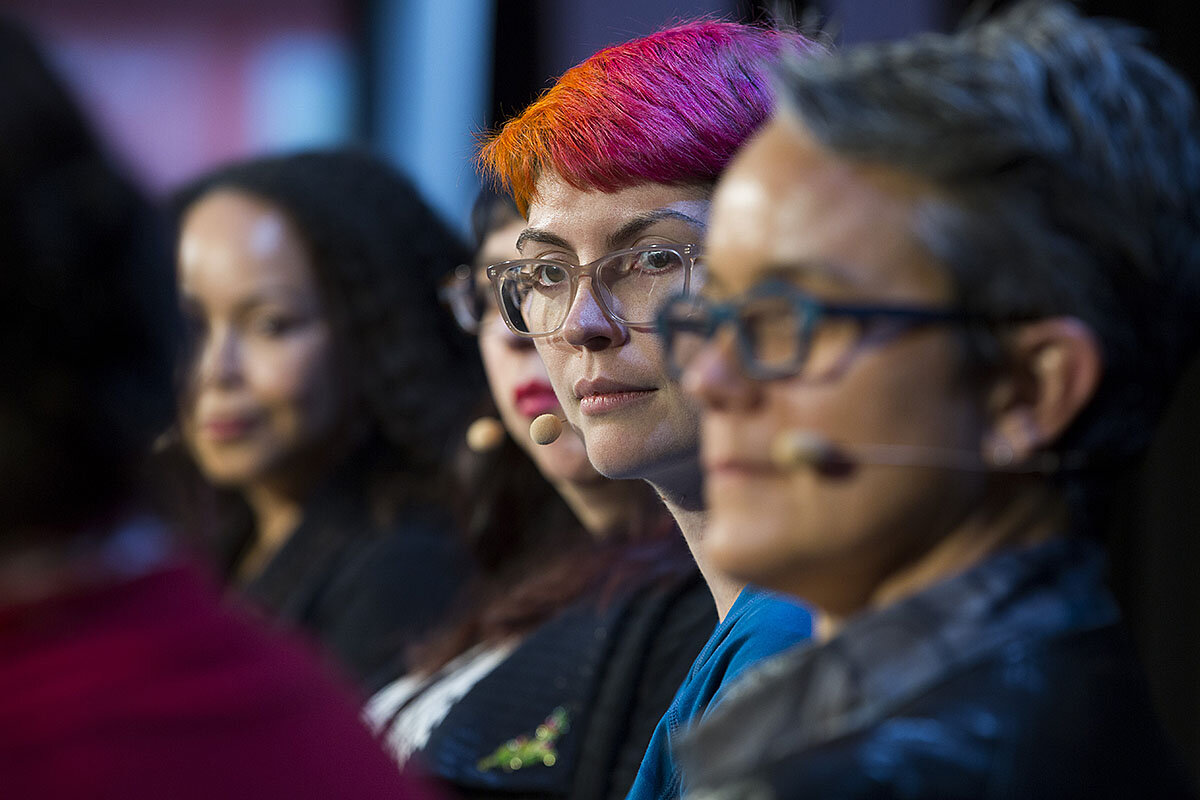
- Quick Read
- Deep Read ( 4 Min. )
-
By Noah Robertson Staff writer
The share of Americans who think men are better suited than women for politics has decreased from 44% to just 13% in the past five decades, according to the General Social Survey at the University of Chicago. Today, only 4% of Americans say they won’t support a woman for president. With these changes as a backdrop, a woman won the popular vote for president four years ago. But the ranks of women in elective office have grown slowly, and the U.S. Congress is still more than three-fourths male.
In workplaces, perceptions of women’s competence have soared since polling began in the mid-20th century, says Alice Eagly, a professor of psychology at Northwestern University and a leading expert on gender norms. Yet stereotypes persist. Men are perceived as stronger in “agency” traits like assertiveness, while women are seen as more communal, she says. Just 7% of Fortune 500 corporations are led by a female CEO.
“That’s the myth in some ways, when we look at things and say 100 years ago it was so much worse ... that things are always getting better,” says Leisa Meyer, a historian at the College of William and Mary.
Sexism isn’t a relic of the past. How men’s views are shifting.
Cory Weller, a recent college graduate and resident of Columbia, Maryland, says he supports gender equality. He’s voted for a woman. He reports to a female manager at work. In college, he took a course on feminism.
His thoughts on gender don’t run in the family. Mr. Weller says his father would balk at a female leader or boss. It’s a difference that, in his opinion, comes from circumstances as much as stereotypes. More than half of his bosses have been women, he says, and none of his father’s have been.
“There are no real differences in males or females that should set them apart from having equal roles,” says Mr. Weller, “which I feel like is kind of a new viewpoint.”
In part, the younger and older Wellers represent America’s shifting attitudes toward gender, which have been especially malleable since the ratification of the 19th Amendment a century ago.
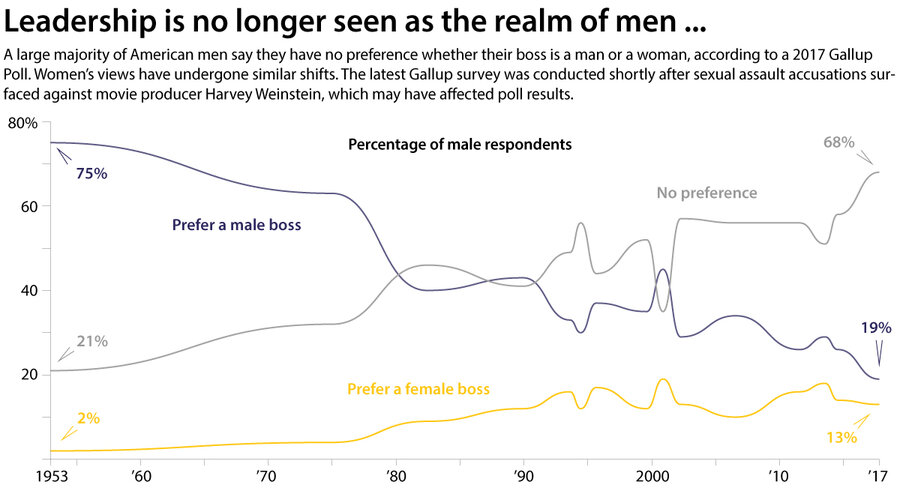
Gallup
Yet, even as attitudes keep evolving for young and old alike, the reality on the ground has a lot of catching up to do. Leadership roles in both business and politics are still occupied heavily by men.
One moral of the story, say legal scholars and historians, is that new perspectives alone don’t eradicate biased behavior. It requires focused effort to dismantle systems and traditions that inhibit women’s advancement. Perception shifts are just one step – but an important one.
“At what point does culture change?” asks Swanee Hunt, a former U.S. ambassador to Austria and a scholar at Harvard University. “The answer is it’s changing every nanosecond. It is never not changing, because all culture is, is the way things are being done.”
The shifts over the past century are both significant and incomplete. The share of Americans who think men are better suited than women for politics has decreased from 44% to just 13% in the past five decades, according to the General Social Survey at the University of Chicago. Today, only 4% of Americans say they won’t support a woman for president. With these changes as a backdrop, four years ago a woman won the popular vote for president. But the ranks of women in elective office have grown slowly, and the U.S. Congress is still more than three-fourths male.
In workplaces, perceptions of women’s competence have soared since polling began in the mid-20th century, says Alice Eagly, a professor of psychology at Northwestern University and a leading expert on gender norms. Yet stereotypes persist. Men are perceived as stronger in “agency” traits like assertiveness, while women are seen as more communal, she says. Just 7% of Fortune 500 corporations are led by a female CEO.
“That’s the myth in some ways, when we look at things and say 100 years ago it was so much worse ... that things are always getting better,” says Leisa Meyer, a historian at the College of William and Mary.
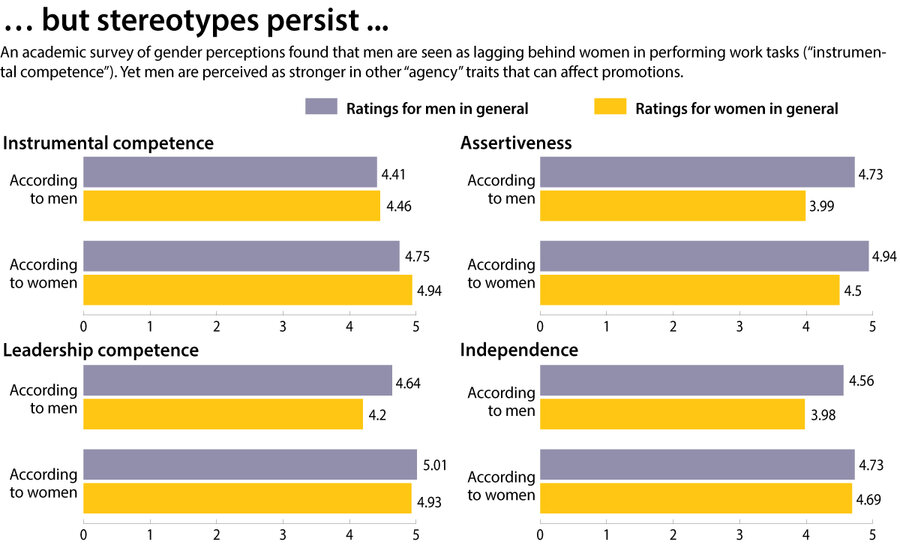
"The Multiple Dimensions of Gender Stereotypes: A Current Look at Men’s and Women’s Characterizations of Others and Themselves" (2019) by Tanja Hentschel, Madeline E. Heilman, and Claudia V. Peus (Frontiers in Psychology)
Compared with a century ago, Dr. Meyer sees progress, but she says far more is needed. Women aren’t only judged differently for the same behaviors, she says; they’re also still thought of as more emotional, worse leaders, and less apt to make hard decisions. Those perceptions tend to be held most strongly by men.
Yet many women hold similar gender stereotypes as well. And that’s an important twist, when it comes to battles for equality. This year, after all, protests for racial justice have encouraged a reckoning over racism in America. In many ways, the quest for gender equality is a parallel battle, but experts say women are less cohesive as a group than African Americans when it comes to a sense of shared struggle against long-standing injustice.
That’s not to say society never confronts sexism. The #MeToo movement unleashed a powerful shift in public thought regarding sexual harassment. Calls for equal pay have also galvanized growing support from men as well as women in recent years.
But achieving lasting change is hard work. Cultural shifts, Dr. Meyer says, involve each generation doing things differently and passing those differences on to the next. And that process is rarely linear.
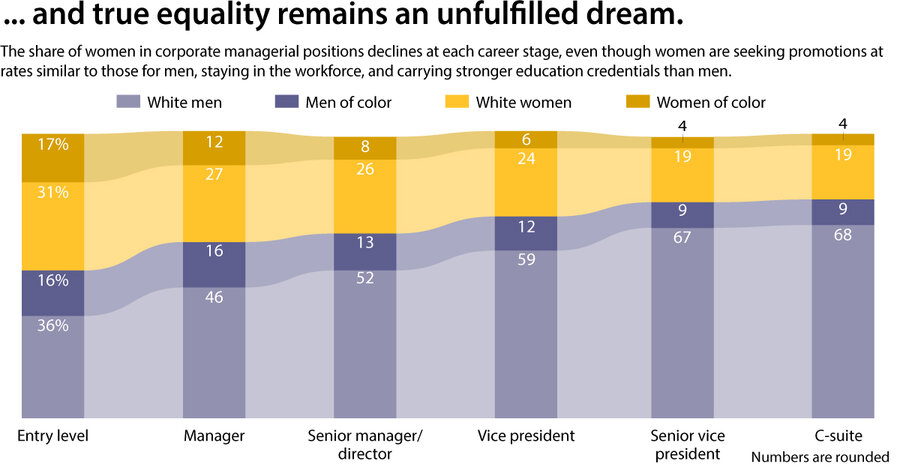
“Women in the Workplace 2018” survey by McKinsey & Co. and LeanIn.Org
Bradley Jean is one young man who thinks stereotypes are losing their sway. A rising senior studying computer engineering at George Mason University in Fairfax, Virginia, he’s excited to already have a plan for work after graduation. The CEO at Novetta, the software company where he has been promised a job, is a woman – Tiffanny Gates. She is a strong leader, he says, and she’s created a culture of open, supportive communication – something Mr. Jean appreciates.
“If [women] have the same qualifications as men,” he says, “they should be judged on the same principles.”
Yet that still rarely happens, says Joanna Grossman, a legal scholar at Southern Methodist University. She describes the workforce as a pyramid shape for women, in which they’re equally represented at the bottom “and they drop off at every meaningful level.” Men in particular need to accept that sexism isn’t just a relic of the past, she says.
Dr. Hunt at Harvard believes that her students should play an active role in ensuring the success of their classmates – women and men. She tells them, “It’s not about ‘Just get out of [women’s] way.’ It’s walk the journey with them.”

Gallup

Where do women lead in the media? South Africa.
How can you tell the world’s story, if only half the world is telling it? For decades, women were scarce in top newsroom roles. But that’s changing, particularly in South Africa – where Black, Asian, and multiracial women’s gains were especially hard-won. Part of our special 100th anniversary edition on women winning the right to vote.
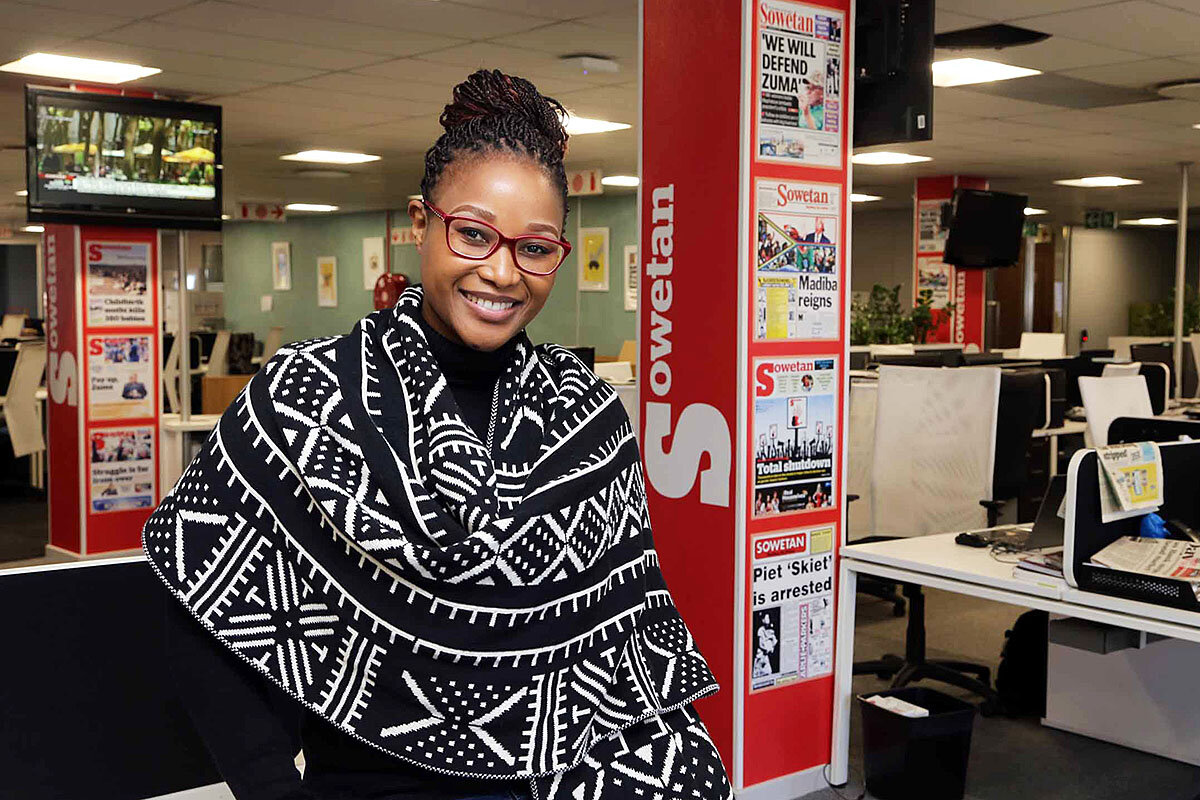
- Quick Read
- Deep Read ( 5 Min. )
Mahlatse Mahlase is group editor-in-chief of Eyewitness News, a major broadcaster in South Africa. It’s a role she would have been unlikely to fill 30 years ago, under the apartheid regime, whose hierarchy put Black women on a bottom tier.
But no matter where you look in the world, women’s leadership in the news media has lagged – and still does. South Africa, in fact, is a relative success story. Today, women lead nearly half of the country’s major publications and broadcasters, according to a recent analysis by Oxford University. That puts it ahead of the United States, the United Kingdom, and even countries held up as models of gender parity, like Finland.
Yet South African women’s gains have been especially hard-won, and incomplete. Women hold few of journalism’s purse strings, for instance.
Ms. Mahlase says she has reflected on representation through a new prism since she gave birth seven months ago to her first child, a boy.
“I want my son to grow up in a world where he has female bosses,” she says. “I want him to grow up listening to women experts on the radio, hearing them as contributors to changing the world and not just as victims of an unfair system.”
Where do women lead in the media? South Africa.
Nwabisa Makunga can point to the exact moment she knew she would become a journalist.
It was April 1993 and she was 11 years old, watching the TV broadcast of the funeral of assassinated anti-apartheid leader Chris Hani with her family in their living room. The presenter was a Black reporter named Noxolo Grootboom, and her powerful tribute to Mr. Hani brought Ms. Makunga’s parents to tears.
“She was a woman who looked like me, who spoke like me, telling the story of a man who had been so important to people from my community,” she recalls. “I said to myself – this is what I’m going to do. I’m going to be like Noxolo, and I’m going to tell stories.”
Three decades later, Ms. Makunga is the editor-in-chief of the Sowetan, one of South Africa’s most-circulated daily newspapers. She is part of a generation of women who have risen through the ranks to take leadership of many of the country’s most important news outlets. Today, these women – most of them Black, Asian, and multiracial – lead nearly half the country’s major publications and broadcasters, according to a recent analysis by Oxford University. That makes the country a global leader for women’s leadership in the media, putting it ahead of the United States, the United Kingdom, and even countries held up as models of gender parity, like Finland.
And the achievement is doubly remarkable in South Africa, where only a generation ago the entire country was run largely by white men. Editors like Ms. Makunga grew up not only with few role models who looked like them, but also in a world where the media was used as a weapon of the apartheid regime, premised on white supremacy – enforcing a hierarchy in which they were the bottom tier.

Hard-won gains
Even after apartheid formally ended, these editors came up in newsrooms where its effects lingered. They were told their accents were “too African,” or their looks “too tempting.” Even as the newsrooms around them began to change from mostly white to mostly not, they still found themselves edged out of the pub trips and golf games where their male colleagues networked their way to the top.
“Make no mistake: Those statistics changing are the result of a fight,” says Mahlatse Mahlase, group editor-in-chief of Eyewitness News, a major breaking-news broadcaster. Women in South Africa’s newsrooms “have fought racism and they’ve also fought the patriarchy. The discrimination came from every side.”
Although they’ve now arrived, many of these same leaders note that South Africa’s media transformation remains incomplete. Women hold few of journalism’s purse strings, for instance. Just 19% of the board members at media companies here are female, according to a 2018 academic study of women in the media called “Glass Ceilings.” The vast majority of the country’s major media houses have a male CEO.
And while the proportion of Black, Asian, and multiracial women in the top echelons of South African media companies has grown from 6% in 2006 to 30% in 2018, that number still lags, in a country where they represent 46% of the population, according to the Glass Ceilings survey. Once they get there, meanwhile, they’re often placed under intense scrutiny and pressure.
“When men get to the top of their profession, they’re celebrated. When women get there, particularly Black women, there’s backlash, there’s trolling, there’s bullying,” says Glenda Daniels, an associate professor of media studies at the University of the Witwatersrand in Johannesburg and the co-author of the Glass Ceilings study. She uses the term “Black” as it is frequently applied in South Africa, to describe anyone who is not white. “Women at the top find they’re often exhausted just proving over and over that they deserve to be in the room.”

Coming up the ladder
In 1994, the same year Nelson Mandela took the oath as South Africa’s first Black president, an ambitious young reporter named Mapula Nkosi walked into the Johannesburg newsroom of the Weekly Mail, which made its name opposing apartheid, to begin her career as a cadet reporter.
When she looked up the ranks, she says, she saw only men. But all around her, the country had a new buzzword: transformation. The process was often fuzzy, but the objective was clear: The structures that ruled the country should look more like the people who lived in it.
“Those newsrooms figured out they needed to mimic what was happening in society so they wouldn’t end up on the wrong side of history,” says Ms. Nkosi, now the editor of the Daily Sun, the country’s most-circulated daily newspaper. “The whole time I was coming up I had people on one side of me saying, ‘We don’t understand why you’re in this position,’ and people on the other side saying, ‘We are so excited to see where you go.’”
Those competing forces followed many of South Africa’s women journalists through their rise. Each time they pulled themselves up another rung on the ladder, they heard whispers – that they only got this job because leadership wanted a woman, that they’d never make it.
But when they did, the conversation changed.
“When you do well, you become almost genderless,” says Paula Fray, a media consultant and the first woman to edit the Saturday Star, a major South African newspaper. “But if you don’t do well, then your failings represent your whole gender.”
Meanwhile, women leaders in the newsroom “carry the added responsibility of making these environments more welcoming for women,” says Mary Papayya, a veteran journalist and editor who now sits on the board of the South African Broadcasting Corp. That, she notes, is a particularly difficult task at a time when many outlets have seen their budgets slashed and are now contending with a pandemic that has made news reporting both more dangerous and less lucrative.
And the fight for change goes beyond who sits in the corner office. In South Africa, like many countries, men are disproportionately both the experts and subjects of news stories. A recent analysis of the South African media’s coverage of the COVID-19 pandemic by the organization Media Monitoring Africa, for instance, found that 80% of those quoted in stories about the virus were men.
Ms. Mahlase, the radio news editor, says she sees these kinds of statistics through a new prism since she gave birth seven months ago to her first child, a boy.
“I want my son to grow up in a world where he has female bosses,” she says. “I want him to grow up listening to women experts on the radio, hearing them as contributors to changing the world and not just as victims of an unfair system.”

Watch
10 inspiring Olympic moments (video)
The Olympic Games display athletic prowess and the resiliency of the human spirit. There may be no Summer Games this year, but great Olympic moments are worth revisiting – especially those that broke physical, cultural, and racial barriers.
Rafaela Silva was born in Cidade de Deus, one of Rio de Janeiro’s sprawling favelas. If it weren’t for judo, Ms. Silva might never have left.
She found the sport through a program designed to keep low-income children off the streets. Judo took Ms. Silva to competitions around the world – from Bangkok to Paris to London.
And then it took her home, where Ms. Silva earned the first of Brazil’s seven gold medals at the 2016 Olympic Games in Rio de Janeiro. To a country of more than 200 million, she had become an inspiration.
It’s stories like Ms. Silva’s that draw nearly 200 million people to watch the Olympics every four years, says David Wallechinsky, president of the International Society of Olympic Historians. Sports are about stories, he says, and there is no greater chapter than the Olympics.
Even for the smallest country, “it’s a chance to be part of the world,” says Mr. Wallechinsky.
Since the modern games began in 1896, athletes have used them to break barriers, sometimes doing what entire countries could not.
Despite the postponed 2020 Tokyo Games, the Olympic spirit continues, biding its time until athletes can safely assemble. Until then, Olympic fans can reflect back on those who came before.
This summer, the Monitor did just that. Here are some of our favorite Olympic moments. – Nate Richards, Noah Robertson, and Kendra Nordin Beato
Other headline stories we’re watching
(Get live updates throughout the day.)The Monitor's View
An election with bravery on the ballot
- Quick Read
- Deep Read ( 2 Min. )
-
By the Monitor's Editorial Board
One early sign of a dictator’s eventual demise is the moment when people cast off fear of his retribution against opponents. For Belarus, a small ex-Soviet nation next to Russia, that moment may come Aug. 9 in an election that could be largely rigged to favor its longtime ruler.
For some reason, President Alexander Lukashenko has allowed a candidate that he dismisses as “just a housewife” to run against him.
Little did he anticipate that Svetlana Tikhanovskaya, a former English teacher and translator, would draw big crowds with this campaign pitch: “Now is the time when everyone must overcome their fear.”
If she somehow wins, Ms. Tikhanovskaya says her goal would be to quickly hold a legitimate election within six months, one in which freed political prisoners could run and people do not succumb to fear of retribution. She’s already set an example of that.
An election with bravery on the ballot

One early sign of a dictator’s eventual demise is the moment when people cast off fear of his retribution against opponents. For Belarus, a small ex-Soviet nation next to Russia, that moment may come Aug. 9 in an election that could be largely rigged to favor its longtime ruler.
For some reason, President Alexander Lukashenko has allowed a candidate that he dismisses as “just a housewife” to run against him. Perhaps he needs a sheen of democracy. Or he actually believes his statement that Belarus “has not matured enough for a woman” to become president.
Little did he anticipate that Svetlana Tikhanovskaya, a former English teacher and translator, would draw big crowds with this campaign pitch: “Now is the time when everyone must overcome their fear.”
Ms. Tikhanovskaya certainly has plenty to fear herself. In May, her activist husband was jailed after he announced his candidacy. Two other candidates were jailed or went into exile. At that point she decided to run. Even then, threats were made against her two children. She has sent them out of the country.
After hitting the campaign trail, however, the once-shy Ms. Tikhanovskaya realized she could pop a bubble of fear among Belarus’ 9.5 million people, especially the urban, tech-savvy youth.
“Do you think I’m not scared? I’m scared every day,” she told a crowd. “But I muster my courage, get over my fear and go to you, and go for victory.”
She also realized that the president’s dismissive attitude toward the coronavirus pandemic has awakened people. “They began to feel that they were protected by other people and not by the state,” she says.
Her popularity has been measured in the size of her crowds – the largest since independence in 1991. No political polls are allowed. In a rare TV appearance, she bravely talked about political prisoners.
She knows the election might be rigged against her. Mr. Lukashenko has been in power since 1994. She asks people to show solidarity by wearing something white when they go to vote. She also asks them to take pictures of their ballot and record their vote on an opposition website.
Under authoritarian regimes, such tactics are the tools of the powerless. Yet real power lies first in setting aside fear and embodying the qualities of democracy, such as equality and freedom.
If she somehow wins, Ms. Tikhanovskaya says her goal would be to quickly hold a legitimate election within six months, one in which freed political prisoners could run and people do not succumb to fear of retribution. She’s already set an example of that.

A Christian Science Perspective
Each weekday, the Monitor includes one clearly labeled religious article offering spiritual insight on contemporary issues, including the news. The publication – in its various forms – is produced for anyone who cares about the progress of the human endeavor around the world and seeks news reported with compassion, intelligence, and an essentially constructive lens. For many, that caring has religious roots. For many, it does not. The Monitor has always embraced both audiences. The Monitor is owned by a church – The First Church of Christ, Scientist, in Boston – whose founder was concerned with both the state of the world and the quality of available news.
Show me infinity!
If our joy, harmony, or sense of home feels constricted, it’s worth considering the limitless, unconfined nature of God and God’s creation.
-
By Jennifer Youngman
Show me infinity!
A friend of mine was on a waitlist for subsidized housing for several years. When a place became available she was delighted – until she saw how tiny that particular unit was! But if she didn’t take it, she’d lose her place on the list.
I offered to design a potential room arrangement. But when I diagrammed the apartment and my friend’s furniture, fitting her modest belongings in the apartment looked geometrically impossible. It was hard to picture the space feeling like home or a place where loved ones could gather. And for a moment, I succumbed to the sadness that was hanging over the move in general.
So I opened my heart to God. The prayer that came to me was “God, show me infinity.”
Our identity – which includes our sense of home and purpose and right activity – is a concept. A concept can’t be restricted or squeezed into a physical space of any size. In the Bible, the Apostle Paul, a follower of Christ Jesus, preached that “we live, and move, and have our being” in God (Acts 17:28). God, Spirit, is infinite. So where we live is infinite. Our expression of God-given individuality is unconfined.
Mary Baker Eddy, the discoverer of Christian Science, studied the Bible, especially the words and works of Jesus. From this she came to understand that the infinity of God is a practical spiritual fact operating in our daily lives. She writes in “Science and Health with Key to the Scriptures,” “The finite must yield to the infinite” (p. 256).
And it does! As I prayed to see the infinity of God, good, in operation, solutions started to come. Over the next few weeks, ideas developed for how that tiny apartment could accommodate bookshelves, rocking chairs, and family treasures – with room to spare for friends to gather and play their fiddles together.
Our homes, our lives, and our prayers don’t have to be big. They just have to be ... infinite.
Adapted from the July 7, 2020, Christian Science Daily Lift podcast.

A message of love
Go West
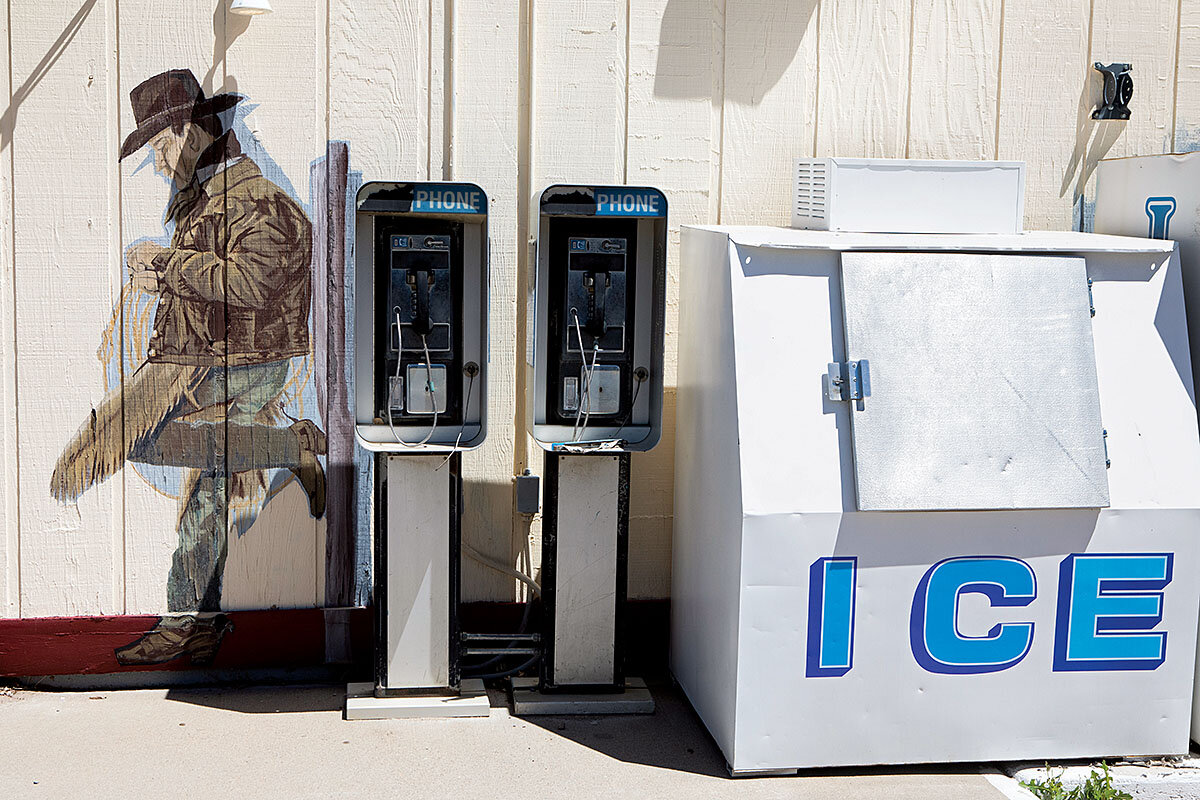
A look ahead
Thank you for joining us. Please come back Monday, when Monitor reporter Laurent Belsie explains how political brinkmanship over pandemic relief threatens the economy.




